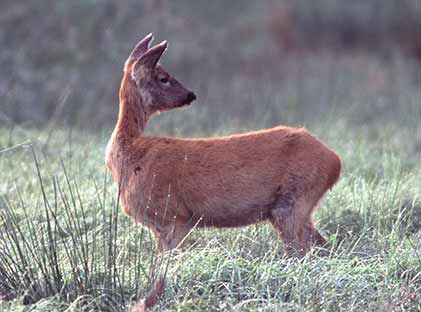New Forest deer: obtain closer views - fieldcraft

Obtaining good, close views of New Forest deer, if the venture is to be successful, depends on the development of a range of fieldcraft skills intended to neutralise the deer’s senses of smell, hearing and sight. Check out the pages outlining the general principles to be followed and the suggestions for clothing and equipment, then follow the advice on this page; and stalking deer will provide many hours of pleasurable pursuit and watching.
Smell
Deer sense of smell is particularly strong. Indeed scent will often betray a silent, otherwise effectively concealed watcher. Combat this by always being aware of the wind direction, and trying at all times to stay downwind of the deer so that your scent will not be carried towards them. And if deer are first noticed downwind, take a circuitous route to a better position to avoid them picking up your scent.
Hearing
Deer have excellent hearing and the ability to raise and twist their ears about so as to better pinpoint sound sources. To combat this:
Tread carefully and pick up your feet – shuffling is sure to cause excess noise.
Avoid standing on twigs or sticks that will crack noisily underfoot. Beech mast, too, has a nasty habit of crunching loudly when trodden on, and dry leaves can cause what seems to be an explosion of sound in the quiet of a wood.
Try to avoid gravel tracks and the attendant potential for noise - if there’s no other suitable alternative route, walk on the grassy side-verges.
Be careful when using gates, prevent them banging shut and hope that hinges do not squeak.
Photographers, be careful when using tripods - when extended these often essential items of equipment have a nasty habit of taking on a noisy, uncontrolled life of their own as they brush against overhanging branches, brambles and other vegetation. Tripod adjustment mechanisms can also be a source of noise – the metal handle on my old Benbo tripod, for example, if left to swing freely, used to bang against the tripod's other metal parts making an inevitable racket.
Be careful, too, with loose straps on camera or other bags, straps that can catch in vegetation or knock noisily against the bag.
Zips, too, when opened or closed are incredibly noisy, so avoid use whenever possible. If there’s no alternative, suppress the noise by applying pressure to the area of the zip, and sliding it very slowly.
Sight
Deer eyesight is pretty good, but it’s often movement that betrays human presence. Always, then:
Try to avoid sudden, eye-catching movements. Walk slowly, quietly, and do this always so that it becomes second nature.
Avoid crossing areas of open land, for people out in the open are likely to be incredibly conspicuous. Whenever possible, walk alongside adjacent woodland edge.
When in sight of deer, try to move only when the animals are not looking, when they’re busy feeding or are otherwise distracted.
When approaching deer, try to keep an obstruction - a tree trunk, a branch, a holly or gorse bush - in-between you and the deer. This will break up your outline, conceal your movement and confuse the deer’s senses.
And finally, if the deer do see you, but do not bolt, immediately look away, for deer and many other animals will often stand and stare when they think they’ve not been seen - they feel secure, confident that unthreatened. In these circumstances, always avoid walking directly towards them - a route to the side or away from them might eventually provide opportunities for getting closer.
New Forest deer - obtain closer views
New Forest deer - find out lots more
References:
The History of British Mammals: Derek Yalden
Roe Deer: John K. Fawcett, British Deer Society
New Forest Roe Deer: John K. Fawcett
Deer Watch: Richard Prior
Mammals of Britain and Europe: David McDonald, Priscilla Barret
Field Guide to British Deer: F J Taylor Page
More links
Other related links
Search this site

Sadly, 58 animals were killed - 35 ponies, 13 cows, 8 donkeys and 2 sheep, whilst a further 32 were injured - 3 pigs, 9 donkeys, 11 cows and 9 ponies.
(Forty-three accidents occurred in daylight, 15 at twilight and 101 in the dark. Twenty-seven accidents were not reported by the driver involved).
Here's just one horrific example - Three donkeys killed in collision with van at notorious New Forest blackspot (Advertiser and Times)

